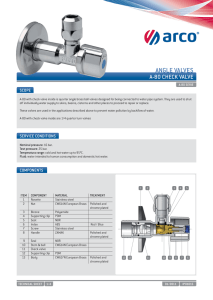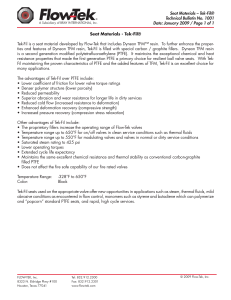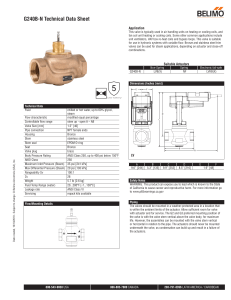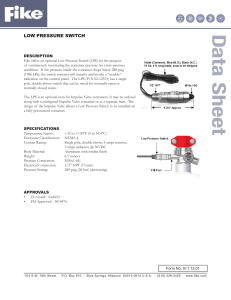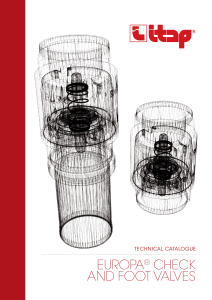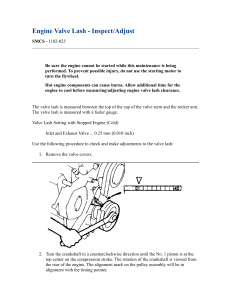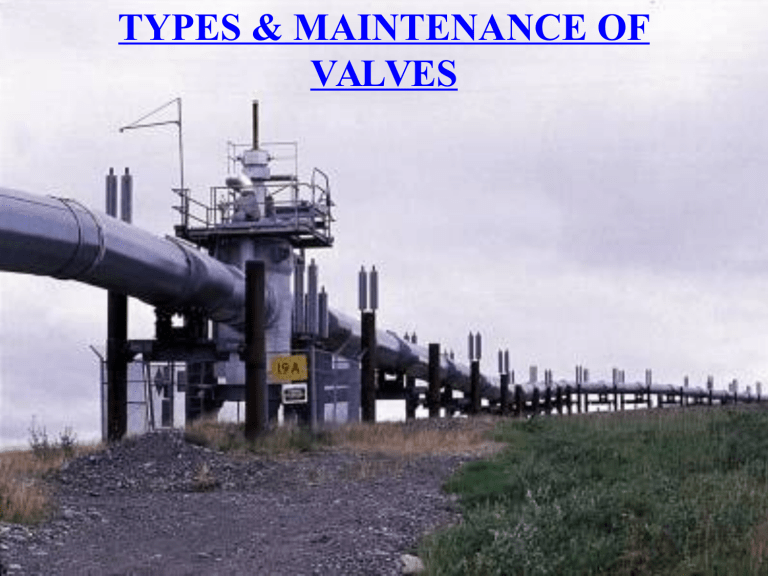
TYPES & MAINTENANCE OF VALVES TYPES OF VALVES Valves are simple in concept. The basic idea consists of placing a disc over a seat opening in such a way that the resulting closure is tight. From this simple idea, three basic design of valves have emerged: • Gate Valve • Globe Valve • Check valve A valve is mechanical device usually used in connection with a pressure containing vessel to stop or regulate flow THREE BASIC DESIGNS OF VALVES GLOBE VALVE CHECK VALVE GATE VALVE GATE VALVES Gate valve Gate valves are the most popular & most frequently used of all three types of valves. As their correct installation calls for usage where they are opened and closed only occasionally, they last a long time and do not require much maintenance. If a gate valve operates ten times a day it will wear out quickly. The wear will be found on the down stream faces of the seat and the disk. The up-stream faces are not damaged normally. Thus very often worn gate valves can be reversed 180 degree & they will be as good as new. Gate valves should be installed with stem vertical .Horizontal position is permissible but not recommended GATE VALVE Gate valves are installed where they are not operated very often and hence do not wear out quickly and they do not as a rule have the maintenance features of globe & check valves. Mechanical devices should be operated occasionally. Valves which are placed in lines and then forgotten may become hard to operate. This is specially so in hot water lines, hard water lines or any other lines in which there is tendency to deposit scale or solids. Valves actually have been known to scale up or coke up badly over a period of years that they had to be dissembled and cleaned before they are usable. Gate valve types Various designs of Gate valve are available: a. Double disc bronze gate rising stem valve b. Solid wedge disk rising stem gate valve c. Single wedge disk non- rising stem gate valve d. Outside screw & yoke rising stem gate valve e. Renewable disk & seat bronze gate valve f. Knife Gate valve Gate valve types a. Double disk gate valve The double wedge are of ball & socket construction or of uni-ball type where each single disk has a half socket and half ball. They readily adjust themselves to the taper seats ensuring a tight valve. Very little maintenance is required for the gate. Gate valve types b. Solid wedge disk rising stem gate valve: They are mainly used in heavy liquids or any other liquids that would tend to make the ball & socket disk inoperative.these valves are not as tight on thin liquids or gasses c. Single wedge disk non- rising stem gate valve These are mainly used in marine services. The non rising stem feature allows the valve to be used in cramped spaces where overhead construction interfaces with the operation of the rising stem. Maintenance is same as above. Outside screw & yoke rising stem gate valve Renewable disk & seat bronze gate valve Gate valve types d. Outside screw & yoke rising stem gate valve This valve has a union bonnet & a single wedge disk. This type of valve is used in the lines which leads to the top & bottom connections on the water column of a boiler. It must be locked in open position by means of a chain & padlock so there is no wear on it. It is an emergency valve, hence its maintenance consists in test operation & inspection to see that the valve is in working condition. Gate valve types e. Renewable disk & seat bronze gate valve They have a non-rising stem and renewable nickel-alloy seats and disks. It is very popular in chemical industry as the seat & disk can be renewed for unsatisfactory operation. The valve to be removed from operation. Gate valves are not like Globe valves which can be repaired on the line. GLOBE VALVES Globe valves The seat of a Globe valve touches the seat only at the instant of closing. The seat of all Globe valves is directly opposite to the top opening of the body. This is so as to easily reach at the gate for inspection, maintenance & repair. Types of Globe Valve: a. Threaded bonnet globe valve b. Union bonnet Globe valve c. Plug type Globe valve d. Flat seat Globe valve e. Non metallic disk Globe valve Globe valves a. Threaded bonnet globe valve: It is designed for use in expensive installation where the valve is not used frequently. Because of the construction of the threaded bonnet, it is practically impossible to re-grind the valve b. Union bonnet Globe valve It is basically designed for easy maintenance without removal from line.it can be reground and repaired. A small metal plate clamped between the end of the stem and the disk is used to prevent the disk from swiveling on the stem during regrinding operation. The hand wheel is used for the tool, the bonnet lip is used for a guide in the body neck. Valve resetting tolls which can be obtained in sets can be used to dress up the seat if disk & seat are too worn for grinding Globe valves c. Plug type Globe valve: It is designed for severe throttling, drain, drip, water column blow down and other services where high resistance to destructive action on seat bearing. Maintenance consists of renewing the seat & disk. Because of the hardness these valves present quite a regrinding problems by hand. The hardness is 500 Brinell. Globe valves d. Flat seat Globe valve: These are practically no-maintenance valves and designed for 150-200 lb Pressure. The design is revolutionary and it gives extremely long life & trouble free services. The flat seats have never ben known to leakage and the stem os of a material that has shown practically no wear & tear with over 100000 opening & closing. It is equally efficient in water steam, gas and oil sevices. Globe valves e. Non metallic-disk globe valves: These valves are very popular because of their easy maintenance. Its pressure rating is 200 lb. It is also known as composition disk Globe valve. Its maintenance consists mainly renewing the disk as wears out. Three kinds of disks are available. One for steam, one for water, air, oil and gas and other for oxygen,solvents, acids and alkali.its seat can be resurfaced by a resetting tool. Bronze Globe Valve Union bonnet regrinding globe Renew Plug Valve Flat seal Globe Valve Non metallic disk valve Globe valves Flanged globe valve Forged globe valve CHECK VALVES Check valves Checks valves are the guardians against backflow in a pipeline. These are entirely automatic in action and are of various designs. They fall into two main groups: a. Swing check valve b. Lift check valve A swing check valve is usually used where full flow is desired. Lift check valves are normally used in air and gas or when operation of the check valve is very frequent Variation of basic valves Over the years, with the requirement of specific applications, new variation valves are designed. Two most significant among them are a) Ball Valves b) Butter Fly Valves & C) Knife gate valve a) Ball Valves: The ball valve is an adaptation of the “Taper seat Plug cock valve”. Instead of a taper plug, a perfect sphere with a hole for passageway is used. The ball is rotated on a renewable seat of Teflon.the ball valve is quicker in action & tighter on shut-off that a conventional gate or Globe valve. Variation of basic valves, Ball valve It is a combination of perfect sphere rotating on a practically frictionless seat. Actually the ball valve is gate valve with renewable seat & disk. Ball valves are available in many valve metals with many sealing elastomers and in many designs. Advantage of Ball valve: a) Offers unobstructed flow of a gate valve b) Offers bottle tight shut off of a globe valve c) Offers quick acting, quarter turn operation of a cock d) Easy maintenance Butterfly valves 108” dia Butter fly valve Variation of basic valves Butterfly Valves:There are two types of butterfly valves. Body Type- It has groove or thread connections for the connecting pipelines. Wafer type- It has standard ANSI class plain face CI or CS flanges which is bolted into the pipeline. Advantage: a) They are compact b) Short face to face dimensions & lesser weight c) Quick closing. KNIFE GATE VALVES Similar to a butterfly valve, the knife gate valve has a face to face dimension greatly reducing the weight of this valve & reducing piping design. The valves are available in the range from 2” to 100” diameter. However the disadvantages of these valves are the relatively low pressure use and its inability to provide bubble-tight shut off. Knife gate valves contains cavities which promote contamination. Hence not recommended for purity applications Knife valve KNIFE GATE VALVES Knife gate valves are used in three primary applications: a) Non abrasive slurry services-Pulp & paper b) Abrasive slurry applications- in mining industry c) Large dia water services- waster water system Knife gate valves have the ability to cut through slurries, scales and surface build ups, unobstructed flow paths, small face to face dimensions and large line size availability. The un-obstructed flow path not only provides high flow capacity but even allows large objects, rocks items routinely found in mining processes to safely pass Plug Valves PARTS OF A VALVE 1. Body 9. Gland bushings 2. Bonnet 10. Gate/Plug/Disc. 3. Cover 11. Hand Wheel 4. End Flange 12. Gearing 5. Yoke 13. Motor driving mechanism 6. Yoke nuts 7. Stems 8. Glands GATE VALVE No Name of Parts No Name of Parts 37 Hand wheel 1,2 Stud & nut 38 Body unit 3 Pipe Plug 39 Bonnet 7, 9 Cap screw Lower & Top 42 Stem unit 10 Seal O ring 43 Stem down stop 11 O ring stem seal 44 Stem nut 12 O ring bonnet seal 55 Gate 13 O ring seal seat gasket 25 Lock washer 27 Spring 28 Stem protector 29 Vent plug 30 Cap 32 Pipe plug 33 Gland bushing 35 Bearing 56 Seat ring Groove valve with gear Diagrams of flow conditions GLOBE THROTTLE GATE WIDE OPEN GATE THROTTLE INSTALLATION OF VALVES Valve connections Valves are used in connection with pressure containing vessel. There are various connections available like Screw end Flange end with flat or raised face Butt welding end Socket welding end Solder end Union end etc. The selection of proper end-connections on a valve frequently eliminates a lot of maintenance. Installation of Gate or Globe valve When an ordinary Globe valve is used to regulate flow, throttling can result and cause wear of the seat and the disk. For tight closing it sometimes is better to use two valves on the line one for throttling and other is either full open or closed. Also because of the construction, the Globe valve is recommended when the valve is to be operated frequently. The disc of a Globe valve touches the seat only at the instant of closing. Whereas in a Gate valve the disc travels over the full ace of the seat and consequently sliding wear will develop. INSTALLATION OF CHECK VALVE: PIPING PRACTICE When installing a check valve in liquid lines, following should be adhered to: 1. It should be installed as far as possible from pump discharge 2. Do not use swing check valve on the reciprocating liquid pumps, only vertical lift type valve be used. 3. In case of water hammer, noise,or shock during closing of a swing check valve, it should be replaced by a vertical lift valve but size should increased so that pressure drop will remain the same for the same flow. Valve Construction Body. Bonnet,Cover,End Flange, Weld end- Is made from Cast Steel conforming to API Table3.1 Bonnet & Cover Bolting: - Vary from manufacturer to manufacturer Non metallic Parts: - Packings, Inject able materials & Lubricants are recommended by manufacturer VALVE SEALS When compared to Viton® elastomers, Kalrez® has lower out gassing characteristics for any given temperature from ambient to 250°C. Other special seal materials may be discussed with the MDC technical sales engineers. Installation of a gate seal is accomplished by pressing an O-ring into the groove first at the 12 and 6 o'clock positions then at the 3 and 9 o'clock positions, etc. Pressing the O-ring into the groove in this manner avoids twisting the O-ring. Maintenance of valves Failure of valves & Rectification 1. Stem gland leakage a) Replace the gland b) Check the integrity of the stem mating surfaces 2. Body bonnet leakage a) Replace the bonnet gasket 3. Seat & gate leakage a) Check the gate seating faces & repair the faces or replace b) Remove the seat rings & clean/replace the O ring c) Check the seat faces Stem gland replacement Open the valve after depressurizing the line 1. Remove the locking device of the position indicator. Remove the reducer gear box/actuator and the position indicator rod 2. Unscrew the yolk nuts from the stem 3. Extract the Gland by a suitable tool 4. Clean & lubricate or replace the O ring if necessary 5. Clean & lubricate the housing into the bonnet and insert the gland 6. Insert the yolk ) & reassemble the parts 7. Yolk nuts & bolts should be tightened alternately carefully. BONNET GASKET REPLACEMENT 1. Depressurize the line 2. Open the gate completely 3. Secure the bonnet with a suitable lifting device through the yolk 4. Unscrew the bonnet stud nuts (p-10), remove the nonnet studs (P10) and the bonnet retainer (P-41) 5. Lower the yoke-bonnet (P-19-5)as far as to clamp the retainer ring (P-40) and remove it. Then lift the yoke-bonnet (P-19-5) 6. Take off the old gasket (P-6) & clean the mating surface 7. Check the Gate seating faces & seats faces 8. If OK grease them or else replace 9. Replace the bonnet gasket (P-6) after greasing. SEAT OF THE BODY & GATE CHECKING 1. Open the gate completely 2. Remove the yolk bonnet 3. Remove the stem & gate carefully in order to avoid any damage to the surfaces 4. Check the gate seating faces & seat rings condition. If rqd. Remove the seat ring clean & replace the soft insert & the O ring 5. Clean & grease the seats housing 6. Assemble the valve Maintenance of seal rings MAINTENANCE OF SEAT RING Seat Ring Units : There are three types of seat ring assembly which differ according to the Belleville Spring mounting. Be sure springs are positioned properly as shown in the following diagrams. Coat parts with heavy grease in order to make them stick together during assembly and to prevent cutting the O-rings. A. Belleville Spring mounted in seat recess in body : Position Belleville spring in seat recess in body so that outer diameter of spring will not touch the seat ring tail except when spring is fully compressed : Assembly seat ring units, consisting of seat ring, inner seat ring, seal and gasket O-rings. MAINTENANCE OF SEAT RING B. Belleville Spring mounted on shoulder of seat ring : Assemble seat ring units, consisting of seat ring, inner seat ring, seal and gasket O-rings. Position Belleville Spring on shoulder of seat ring so that outer diameter of spring will not tough the seat ring except when spring is fully compressed : MAINTENANCE OF SEAT RING C. Twin mounted on shoulder of seat ring : Assemble seat ring units, consisting of seat ring, inner seat ring, seal and gasket O-rings. Position two Belleville Springs on shoulder of seat ring so that inner diameters touch each other : INSPECTION OF VALVES Inspection of valves in service Valves shall be dismantled at the time of specified comprehensive inspection or during the shutdown of the line to permit examination of all internal parts. Body thickness measurements shall be made at locations inaccessible before dismantling, particularly at locations showing evidence of erosion. Bodies of valves operating in severe cyclic temperature service shall be checked internally for cracks. Inspection of valves in service Gate valves, which have been used for throttling, shall be measured for thickness at the bottom between the seats, as serious deterioration may have occurred because of turbulence. This is particularly weak point because of the wedging action of the disc when the valve is closed. Inspection of valves in service a) The seating surface shall be inspected visually for defects which might cause leakage. b) The wedging guides shall be inspected for corrosion and erosion. c) The stem and threads on the stem and in the bonnet of valves shall be examined for corrosion which might cause failure., d) The connection between stem and disc shall be inspected to assure that the disc will not detach from the stem during operating. INSPECTION OF CHECK VALVES (OISD-130) Swing check valves shall be inspected by removing the cover or cap. The clapper or disc shall be checked for freedom of rotation and the nut holding it to the arm shall be checked for security and presence of a locking pin, lock washer, or tack weld. The arm should be free to swing and the anchor pin shall be inspected for wear. Also the seating surface on both the disc and valve body shall be checked for deterioration by feeling them with the fingers. After the valve has been reassembled, it shall be tested hydrostatically and/or pneumatically for tightness. If tested pneumatically, a soap solution shall be applied to the edges of the seating surface and observed for any evidence of leakage. INSPECTION OF FLANGE,GASKET & BOLTS (OISD-130) The gasket faces of flanged joints, which have been opened, shall be inspected visually for corrosion and for defects such as scratches, cuts and gouges which might cause leakage. The gasket faces shall be checked for true flatness or warping by placing a straight edge across the diameter of the face of the flange and rotating it about an axis through the centre line of the flange. Grooves and rings of ring joints shall be checked for defects. Preventive Maintenance of Valves 1. GENERAL : ALL THE STATION VALVES SHALL BE MAINTAINED REGULARLY TO ENSURE THEIR SAFE AND PROPER OPERATION DURING THE COURSE OF NORMAL OPERATION AND IN CASE OF ANY EMERGENCY. 2. MAINTENANCE SCHEDULE AND REPORTING : a) ALL THE STATION VALVES SHALL BE LUBRICATED EVERY MONTH. b) THE DRIVE BUSH OF THE MOTOR OPERATED VALVE SHALL BE CHECKED EVERY 2 YEARS. Preventive Maintenance of Valves c) EVERY VALVE SHALL BE CHECKED FOR PASSING OF THE GATE BY OPENING THE BOTTOM DRAIN VALVE ONCE IN A YEAR. d) THE VALVE SHALL BE INSPECTED AND COMPLETELY OPERATED ANNUALLY AS PER THE PROFORMA NO. PL/MNT/(M)/52. e) ALL THE MOTOR OPERATED VALVES (MOVs) ARE TO OPERATED ELECTRICALLY (ON LOCAL AS WELL AS REMOTE) AND INDICATION LIGHT TO BE WATCHED CONTROL PANEL TO ENSURE PROPER FUNCTIONING THE ACTUATORS. BE ON ON OF THANKS 17

